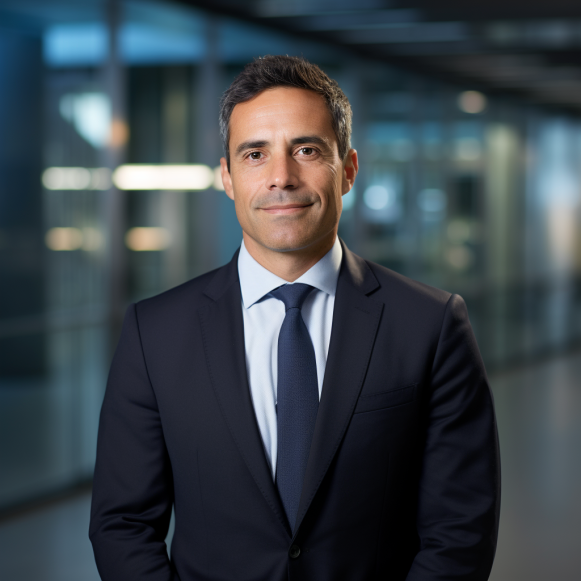Deutsche Bank’s chief innovation officer lifts the hood on the German bank’s AI strategy as it hires hundreds and runs dozens of pilots

- Deutsche Bank is aggressively experimenting with AI capabilities to transform the bank.
- DB is going on a hiring spree, trying to more-than double its AI employee base of around 300.
- But uncertainty around regulation, talent wars, and the cost of scaling the tech won’t make it easy.
A group of men gathered around a half-dozen computer screens erected overhead. They were confronted with what could be the future of banking.
They asked the machine about the performance and ESG strategy of a fictitious company called Cymbal, using a touchscreen pre-populated with questions. The screens flashed with line graphs, bar charts, company reports, and stock charts. Then they cut to black before the text appeared to provide information on Cymbal, a fictitious corporate client of Deutsche Bank.
The tool provided a client briefing, as well as a report to prepare investment bankers for client meetings. What would normally take a team of junior bankers a day or two to put together was produced in seconds thanks to generative AI.
The German bank’s interest in the buzzy technology was on full display in late August at Google Cloud Next 2023 in San Francisco. Live demos of genAI tools drew a steady stream of admirers as they played with beefed-up chatbots that could switch languages in the middle of a conversation, dashboards that brainstormed potential clients, and a new way to generate software code.
Since the splashy debut of ChatGPT, generative AI has become all the rage on Wall Street. Despite Wall Street’s interest in and investment in generative AI, many companies are still investigating potential applications.
Deutsche Bank aspires to transform the banking industry and its workforce. The company is currently running approximately 25 pilots, with many experiments set to go live in early 2024. It plans to double or triple its AI-related workforce in the coming year, as well as retrain existing front- and back-office employees, as the technology pervades DB’s ranks, from HR to technology to the investment bank. However, it will be a trusting moment for the bank, with a minefield of unknowns such as future costs, evolving regulations, and a raging talent war.
“It’s like net new in generative AI.” There are no standards. “There are a lot of assumptions,” said Gil Perez, chief innovation officer at Deutsche Bank.
“You basically need to get people to take a leap of faith and say, ‘Yes, I understand that we don’t have all of the details, but we will get there.'” And that is extremely difficult for many boardrooms and CFOs,” Perez said.
From the back office to the boardroom
Deutsche Bank has been developing its AI strategy since 2021, a year after switching to the public cloud and partnering with Google Cloud. A centralized AI team of under 100 technologists develops core AI capabilities.
The bank is aggressively hiring more technologists to expand its artificial intelligence empire. All of Deutsche’s AI projects employ between 300 and 400 technologists. According to Perez, the bank’s team will at least double, if not triple, in the next year.
A Deutsche Bank spokesperson declined to comment on the amount of money the bank is investing in artificial intelligence.
The bank’s approach is distinct in that it is driven by approximately 13 chief operating officers who span the firm and suggest ideas for how to improve their business lines through technology.
Technology is evolving at an unprecedented rate as the business drives the momentum behind Deutsche’s AI ambitions. Typically, technology must persuade the business to allocate budget before developing a new capability or tool — and this is often met with pushback due to years-long product roadmaps, according to Perez.
However, when ideas are generated by businesses themselves, tech teams are given the green light to move faster.
“The analogy is that we’re no longer pushing; we’re being pushed,” Perez explained.
Reimagining Corporate Banking
A day in the life of a Deutsche banker could look very different as early as January. The corporate bank serves Deutsche’s institutional clients, financial services firms, and investors, generating 1.6 billion euros, or more than $2 billion, in revenue in the second quarter.
Since February, the division has been a hotbed of experimentation, with many of the use cases aimed at improving time-consuming processes typically handled by junior ranks.
The pilot on display at the Google event generated a client briefing with the press of a few keys.
The time saved will allow junior bankers to spend more time critically thinking about the client, industry headwinds, or something a client isn’t doing that its competitors are, according to Tamara Bitticks, vice chair at the corporate bank. She added that bankers can focus on developing people skills such as trust, reading the room, and being a good listener.
“What I find difficult with our juniors a lot of the time is that they’re so focused on gathering that they don’t think about analyzing,” Bitticks said.
“It will be a new way of being a banker,” she predicted.
Deutsche Bank is currently testing a genAI chatbot for corporate and investment banking clients. It can answer complex questions. For example, if a client needs to update account signatories, the chatbot can provide the total number of accounts where a specific person is a signatory or authorizer.
The chatbot will be available in the first quarter of 2024, according to the bank. It is being tested on a sample of everyday customers as well as HR employees internally. According to Perez, the reusability of these so-called core platforms will be a critical component of how Deutsche scales its AI capabilities.
Unknowns and risks
Deutsche Bank’s genAI journey won’t be easy to pull off.
The bank will have to compete for in-demand AI tech talent, which is a market that is only going to get hotter. It will also need to develop retraining and upskilling programs for existing employees across the organization, not just the developers building the technology.
“We’re going to make sure that people understand that you now have someone who helps you, just like a personal assistant does, but at the end of the day, you have to take responsibility,” he said.
In addition, there is a chasm between regulatory acceptance and generative AI. Many Wall Street innovation and technology teams are frustrated by red tape, but how Washington D.C. will regulate genAI is unknown.
Another difficult unknown will be determining the technology’s return on investment. Finance firms, unlike other advancements such as the public cloud or mobile apps, lack a precedent to compare themselves to.
“That makes the boardroom discussion when you’re trying to quantify this a lot more difficult, a lot more challenging,” Perez explained.
And, once the pilots graduate and the technology goes live, the pricing of these compute-intensive genAI applications could increase by 10 or 20 times, he said.
“This is fantastic, but what will be the payoff?” How do we measure it? What will be the advantage? “The answer is that we don’t know,” he explained.






